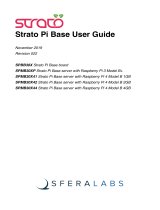
Adjust the Resolution
For the Raspberry Pi 3 and the lower versions, you need reset the resolution ratio as
follows. As for Raspberry Pi 4, when you start up it, the resolution is optimum. If you
want to change its resolution, please refer to the next part.
For Raspberry Pi 3 or Lower Version
Step 1: Open config.txt.
sudo nano /boot/config.txt
Step 2: Modify the /boot/config.txt file.
1) Define a custom CVT mode (since Raspberry Pi uses the standard rate when
1024x600 is not included, you need to set the aspect ratio close to 16:9) and add the
following lines below #hdmi_force_hotplug=1.
hdmi_cvt=1024 600 60 3 0 0 0
hdmi_cvt=<width> <height> <framerate> <aspect> <margins> <interlace>
aspect ratio 1=4:3, 2=14:9, 3=16:9, 4=5:4, 5=16:10,
6=15:9
0=margins disabled, 1=margins enabled
0=progressive, 1=interlaced
0=normal, 1=reduced blanking
2) Find the following lines, delete the "#" mark and modify the value like this:
hdmi_group=2
hdmi_mode=87
....
hdmi_drive=2
hdmi_group=2 means DMT (Display Monitor Timings, the standard typically used on
monitors)



















